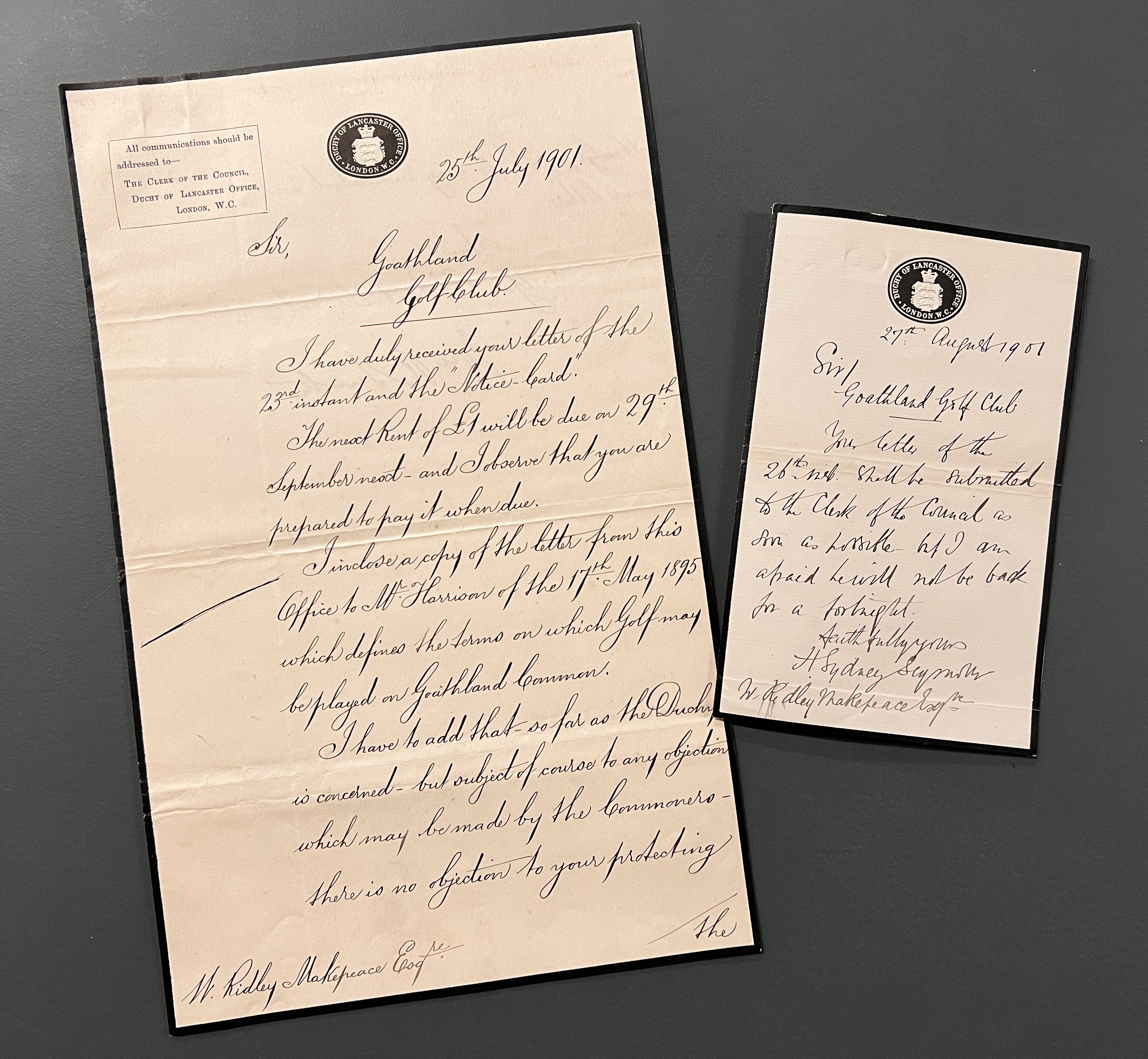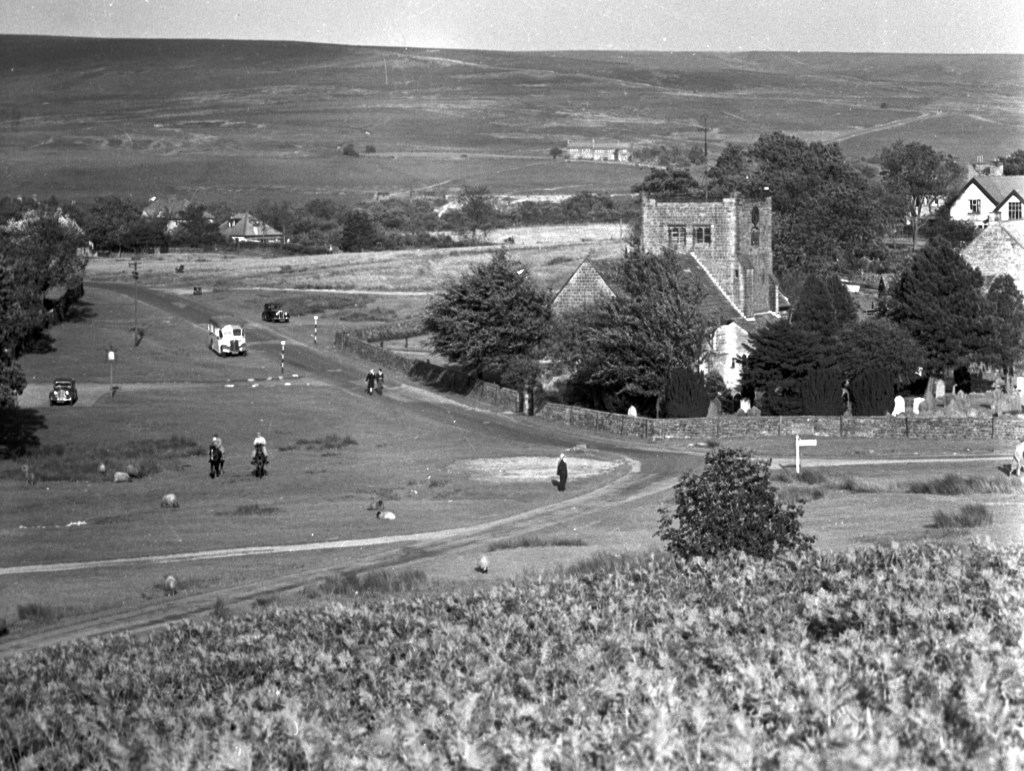The collections of the Record Office include archive material from Goathland Golf Club, 1895-1948 [ZSX]. Described by the Daily Mirror in 1913 as ‘probably the most novel golf course in England‘, Goathland Golf Club was founded in 1895, when Whitby Golf Club relinquished the right of playing on Goathland Common granted to them in 1890 by the Duchy of Lancaster. A new lease was then granted to the owners of the Goathland and Mallyan Spout Hotels, who co-opted a committee consisting of the vicar, the schoolmaster, the station master and one other.


ZSX Correspondence from the Duchy of Lancaster, 1901 and Goathland Golf Club minute books nos 1-3, 1901-1922
Under their leadership, the course became neglected and, in 1901, Edwin Knowles Corrie and William Ridley Makepeace approached the Duchy for permission to reorganise the club on a better footing. A general meeting of members was held, at which Knowles Corrie was established as President, Ridley Makepeace as Honorary Treasurer, the Reverend E.B. Hare as Honorary Secretary and Watson Harrison, John Hill, C. Padel and Louis Rowland as a committee. Subscriptions were set at 10/- for gentlemen, 5/- for ladies and 5/- for non playing members.


Membership during the first year consisted of twenty: six gentlemen, four ladies, seven gentlemen holders of family tickets representing twenty five players, and three non-playing members. However, from the beginning, the course was seen more as an attraction to visitors coming to Goathland for the scenery and moorland, and the club was at pains to point out that they did not see themselves as rivals to Whitby Golf Club. A news report remarked:
“The enterprising executive of the golf club have just issued in handy form a plan of their course which cannot fail to prove useful & interesting to all visitors. We need scarcely say that these links are in no sense a rival to those at Whitby but are intended to be an added interest and attraction to Whitby visitors who go to Goathland for the moorland breezes.”


ZSX Plan of Goathland Golf Links, undated [pre-1923] from which you can see just how close the holes were to the village, and plan of land for tennis court, undated blueprint
The course consisted of nine holes, varying in length from 105 yards to 368 yards, set around the common in Goathland village and very close to the houses. A photograph of 1913 shows a ball being played off a front door step, and play was frequently held up in order to allow others using the common to pass. The hazard to the general public did not go unremarked, with complaints of danger to people on the roads and of trespass onto private lands and, by 1907, the Club had begun to think of moving.
ZSX Newspaper cutting from the Daily Mirror, 19 September 1913, pasted into the Goathland Golf Club minute book, showing photographs of the golf course in use; (note bottom left, the image of a lady playing a ball off a front door step)
The Annual Report stated:
“Your committee has … recognised the desirability of taking steps to secure a golf course which would not be subjected to the same criticism from non players as the links on the Goathland Common, and it is proposed that … a committee be appointed to make enquiries and report the terms and conditions under which a lease may be obtained of suitable land, if any be available for the purpose.”
At the same time, the course was becoming increasingly popular with forty members in 1909, and a further 160 visitors paying green fees. The Whitby Gazette reported that:
“The golf links must be a tremendous asset for Goathland. At such a spot, the facilities for golfing are specially acceptable … Visitors to holiday resorts, small and large, are now a source of income to the local golf clubs, and help a small resident community to keep the links going. And how visitors from towns must revel in those at Goathland.”
An article on the club in Golf Illustrated, entitled Golf in the Village by Horace Brown, in which he wrote ‘where is there another village green which will admit of a links being planned upon it?‘, provided further publicity. In 1910, steps were taken to reduce the number of players because of course congestion. Temporary fees were increased and this had the desired effect, weekend tickets fell from 45 in 1909 to nine in 1910. The Annual Report declared:
“Thus has the congestion of the links been removed. It was the ‘weekenders’ and those who had not learned either the etiquette of golf, or even the strokes of the game, who have been a source of fear to the ever welcome non-golfing portion of our annual visitors to Goathland.”

Complaints about the golf course continued from time to time, along with attempts to find a new location. A letter of 1918 was addressed to the Clerk of the Council of the Duchy of Lancaster :
“I am writing to ask if you can do anything to stop the golf at Goathland. It is played on and across the public highway and is a source of great danger to pedestrians and general traffic … several persons have been hit by golf balls.”
Asked for their comments, the committee replied that they had received no complaints since 1914 and that the author of the letter did not even live in Goathland!

ZSX Goathland Golf and Lawn Tennis Club Limited List of Members, undated [1930s] and Articles of Association, 1923
In 1923, new premises for the course were finally found. Fifty acres on Moss Rigg were rented initially from Major Brook, who held the sporting rights from the Duchy of Lancaster. His lease expired in 1930 and a new lease of the premises was granted directly from the Duchy. A new nine-hole course was set out by Mr Day of Ganton Golf Club and Mr Thornton of South Shields Golf Club. Money was raised by the formation of a small limited liability company, and the old Goathland Golf Club was superseded by the Goathland Golf and Lawn Tennis Club Limited. Tennis had been played since 1907 and plans were now put in hand for a new hard tennis court.




ZSX Lease of right to play golf over Goathland Common: The King to Goathland Golf and Lawn Tennis Club Limited, 6 January 1930, showing detail of both sides of pendant seal of King George V
For a while, the new club did well but by the late 1930s, membership and visitor numbers were falling. This was attributed to the weather (too wet or too hot!) and to the inability of the club to keep the course in good condition. The establishment of the course from heather moorland had been described as a ‘herculean task’, and maintenance was a never-ending problem. Heather adjacent to the fairways was burnt to try to reduce the problem of lost balls and to make the course more attractive, but the outbreak of war in 1939 dealt the club a blow from which it never recovered. The limited company was finally wound up in March 1949, ending over 50 years of golf at Goathland.

